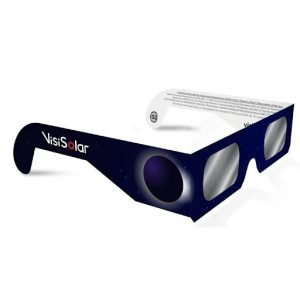Observing an eclipse is a lifetime event, and many are left wondering what to do with a new pair of solar eclipse glasses. Since the next eclipse isn’t visible from the United States until August 23, 2044, keeping them for such a long time is not very useful. In addition to protecting our eyes during the awe-inspiring event, these eyewear pieces could be used for other purposes beyond just protecting our eyes. But instead of throwing them away, there are other things to do that are more beneficial. Recycling, donating, or even repurposing the glasses are all great ways to utilize them.
Recycle
A pair of solar eclipse glasses is at least 1,000 times darker than regular sunglasses, so seeing an eclipse through them is safe. Their solar filters only let in approximately 0.00032 percent of the sun’s visible light (scientificamerican.com). While the lenses themselves aren’t recyclable, the rest of the glasses are. The lenses should be removed beforehand and tossed in the trash, but the cardboard part of the glasses can be recycled.

Donation
Donating solar eclipse glasses can have numerous positive effects locally and globally. Schools, science centers, and community organizations can benefit from these glasses by fostering interest in astronomy and science education, allowing students to observe celestial events while learning about solar safety. Donations promote scientific literacy and inspire curiosity about the universe by increasing access to solar viewing equipment, especially in underserved communities. Donating solar eclipse glasses can have a global impact by supporting international outreach efforts. Organizations often collect donated solar eclipse glasses to distribute to regions where eclipses will be visible in the future, ensuring that people worldwide can view solar eclipses safely.
A simple donation can help advance education, scientific discovery, and global cooperation. Some good places to donate are Astronomers Without Borders or Eclipse Glasses USA. Students with glasses, such as Evan Brunetti (11), would choose the donation route: “I have seen a solar eclipse twice in my life, and I think it’s essential that others view it as well.”
Machaila Williams (11) also believes in donating the glasses: “I think it’s important that other people get to witness the eclipse because they need to see what is going on in their planet. It’s a fun way to explore and get to know our environment and see other cool things that happen.”
Mary Holifeild (10) said, “I think it’s important for other people to witness because it is an event that happens every many years, and people need to experience those things.”

Reuse
After the solar eclipse has passed, solar eclipse glasses can be repurposed or recycled in several environmentally friendly ways. Options include donating them to schools, science centers, or community organizations for use as educational tools or for solar viewing events in the future. You can also use solar eclipse glasses for outdoor activities such as stargazing, hiking, skiing, or other outdoor adventures, as they protect from bright sunlight. Recycling offers an environmentally friendly alternative for those unable to repurpose their glasses. Although solar viewing films may be on the lenses, metal or plastic frames are usually made from recyclable materials. Individuals can minimize waste and environmental impact by participating in recycling programs offered by manufacturers or local recycling facilities.
Observing an eclipse is a once-in-a-lifetime experience, and many people wonder what to do with their eclipse glasses. However, there are better things to do than throwing them away. You can recycle, donate, or repurpose the glasses in many ways that will be better for the environment and its users.


